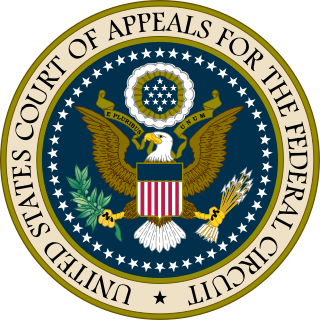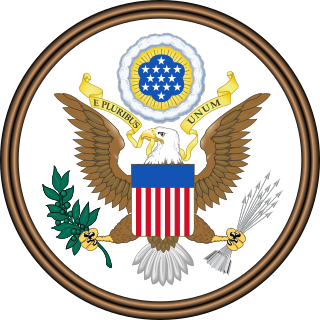Trade dress is a legal term of art that generally refers to characteristics of the visual appearance of a product or its packaging that signify the source of the product to consumers. Trade dress is a form of intellectual property.
Neither software nor computer programs are explicitly mentioned in statutory United States patent law. Patent law has changed to address new technologies, and decisions of the United States Supreme Court and United States Court of Appeals for the Federal Circuit (CAFC) beginning in the latter part of the 20th century have sought to clarify the boundary between patent-eligible and patent-ineligible subject matter for a number of new technologies including computers and software. The first computer software case in the Supreme Court was Gottschalk v. Benson in 1972. Since then, the Supreme Court has decided about a half dozen cases touching on the patent eligibility of software-related inventions.
An interference proceeding, also known as a priority contest, is an inter partes proceeding to determine the priority issues of multiple patent applications. Until the Leahy-Smith America Invents Act of 2011, it was a unique procedure in the patent law of the United States. Unlike in most other countries which had a first-to-file system, the former first-to-invent system of the U.S. allowed a party which has failed to file a patent application on time to challenge the inventorship of another party which had a granted or pending patent, if certain requirements were met.
Business method patents are a class of patents which disclose and claim new methods of doing business. This includes new types of e-commerce, insurance, banking and tax compliance etc. Business method patents are a relatively new species of patent and there have been several reviews investigating the appropriateness of patenting business methods. Nonetheless, they have become important assets for both independent inventors and major corporations.
Patentable, statutory or patent-eligible subject matter is subject matter which is susceptible of patent protection. The laws or patent practices of many countries provide that certain subject-matter is excluded from patentability, even if the invention is novel and non-obvious. Together with novelty, inventive step or nonobviousness, utility, and industrial applicability, the question of whether a particular subject matter is patentable is one of the substantive requirements for patentability.
NTP, Inc. is a Virginia based Corporation founded in 1992 by the late inventor Thomas J. Campana Jr. and Donald E. Stout. The company is widely known for licensing push email patents invented by Thomas J. Campana Jr. and Donald E. Stout to Research In Motion, the manufacturer of BlackBerry for $612.5 Million USD.
In United States patent law, a reexamination is a process whereby anyone—third party or inventor—can have a U.S. patent reexamined by a patent examiner to verify that the subject matter it claims is patentable. To have a patent reexamined, an interested party must submit prior art, in the form of patents or printed publications, that raises a "substantial new question of patentability". The Leahy-Smith America Invents Act makes substantial changes to the U.S. patent system, including new mechanisms for challenging patents at the U.S. Patent and Trademark Office. One of the new mechanisms is a post-grant review proceeding, which will provide patent challengers expanded bases on which to attack patents.

magicJack is a device that plugs into a USB port on the user's computer and has a standard RJ-11 phone jack into which any standard phone can be plugged. This allows the user to make unlimited phone calls to the U.S. and Canada. It is a computer peripheral that, in combination with telephony service from the related YMAX Corporation, provides Internet-based telephone service (VoIP) to the United States and Canada. In 2011 the company introduced magicJack Plus, which no longer requires a computer.

In re Bilski, 545 F.3d 943, 88 U.S.P.Q.2d 1385, was an en banc decision of the United States Court of Appeals for the Federal Circuit (CAFC) on the patenting of method claims, particularly business methods. The Federal Circuit court affirmed the rejection of the patent claims involving a method of hedging risks in commodities trading. The court also reiterated the machine-or-transformation test as the applicable test for patent-eligible subject matter, and stated that the test in State Street Bank v. Signature Financial Group should no longer be relied upon.

The Leahy–Smith America Invents Act (AIA) is a United States federal statute that was passed by Congress and was signed into law by President Barack Obama on September 16, 2011. The law represents the most significant legislative change to the U.S. patent system since the Patent Act of 1952 and closely resembles previously proposed legislation in the Senate in its previous session.
i4i is an independent software company specializing in the delivery of XML / SGML document processing software in Toronto, Ontario, Canada, founded by Michel Vulpe in 1993.
An inter partes review (IPR) is a procedure for challenging the validity of a United States patent before the United States Patent and Trademark Office.
A claim chart is a widely used device in patent infringement litigation. It is a convenient and effective means for analyzing and presenting information regarding a patent claim. In each, typically, there are two columns: the left column contains the language of the patent claim under analysis, separated into the successive limitations of the claim; the right column contains the information relating to the claim element at its left.

Versata Development Group, Inc. v. SAP America, Inc., 793 F.3d 1306, is a July 2015 decision of the Federal Circuit affirming the final order of the Patent Trial and Appeal Board (PTAB), the recently created adjudicatory arm of the United States Patent and Trademark Office (USPTO), invalidating as patent ineligible the claims in issue of Versata's U.S. Patent No. 6,553,350. This was the first case in the Federal Circuit reviewing a final order in a Covered Business Method (CBM) invalidation proceeding under the America Invents Act (AIA). The case set an important precedent by deciding several unsettled issues in the interpretation of the CBM provisions of the AIA>, including what are business-method patents under the AIA and whether the AIA authorizes the PTO to hold such patents invalid in CBM proceedings on the ground that they are patent ineligible under 35 U.S.C. § 101 as "abstract ideas."

The Innovation Act of the 114th Congress is a bill that would change the rules and regulations surrounding patent infringement lawsuits in an attempt to reduce enforceability of patents.

JVC Kenwood Corp. v. Nero, Inc., 797 F.3d 1039, 2015 U.S. App. LEXIS 14402, is a 2015 decision of the United States Court of Appeals for the Federal Circuit concerning the rights of end users who purchase products subject to fair, reasonable, and nondiscriminatory (FRAND) licensing under an industry-wide patent pool of standards-essential patents, and of suppliers of software to the end users. The Federal Circuit held that, where the patent holder had authorized sales to end users of optical discs compliant with the standard, which embodied the patents' essential features and were reasonably intended only to be used to practice the patents, the patent owner had no direct infringement claim against the end users without proof that the end-users were using unlicensed discs. The patent holder therefore had no claim for contributory infringement or induced infringement against a software company for selling software to the end users for use with the licensed discs. The decision is said to be an important one for clarifying the rights of downstream users and their suppliers in the context of patent pools and FRAND licensing.

Enfish, LLC v. Microsoft Corp., 822 F.3d 1327, is a 2016 decision of the United States Court of Appeals for the Federal Circuit in which the court, for the second time since the United States Supreme Court decision in Alice Corp. v. CLS Bank upheld the patent–eligibility of software patent claims. The Federal Circuit reversed the district court's summary judgment ruling that all claims were patent–ineligible abstract ideas under Alice. Instead, the claims were directed to a specific improvement to the way computers operate, embodied in the claimed "self-referential table" for a database, which the relevant prior art did not contain.

Amdocs (Israel) Ltd. v. Openet Telecom, Inc., 841 F.3d 1288, is a panel decision of the Federal Circuit upholding the patent eligibility of four patents on a system designed to solve an accounting and billing problem faced by network service providers, which the district court had held were invalid under 35 U.S.C. § 101 because they were directed to an abstract idea. In the Federal Circuit panel's view, even assuming that the patents were directed to the abstract idea of using a database to compile and report on network usage, nonetheless the patents were eligible to be patented because they contained an "inventive concept"—a combination of elements that was sufficient to ensure that the patents amounted to significantly more than a patent on the ineligible concept itself.
Oil States Energy Services, LLC v. Greene's Energy Group, LLC, 584 U.S. ___ (2018), was a United States Supreme Court case in which the Court held that the inter partes review process granted by Congress to the United States Patent and Trademark Office for challenging the validity of patents, rather than a jury trial, is constitutional and did not violate either Article III of the Constitution nor the Seventh Amendment.



